Steve's Carving Tools
Creator: Steve
Materials: see below
Other Links:.
These are some of the tools I've made for carving bone and antler. I also use them for carving other materials like amber, jet and wood. Some of these tools are based on known examples, others are plausible recreations. The scale in the photographs is marked in centimeters.
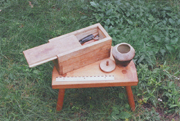
Toolbox and soaking pot
The toolbox is made of pine, pegged and glued together, and has a sliding lid like some small Viking age boxes from Scandinavia and elsewhere. The soaking pot is a small cooking pot based on a period Scandinavian example. I sometimes soak the antler for several hours to soften it before carving.
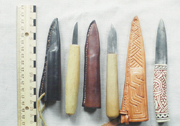
Knives
from left to right:
- Small drop point knife with a wooden handle. This shape has been best for antler and bone, especially incised line work and carving small details.
- Small clip point knife with wooden handle. I keep this sharpened at a more acute angle for work in softer materials like amber, jet, and wood.
- Utility knife, blade by Ketil. This is my daily use knife for cooking, eating, whittling, and showing off a carved piece of antler.
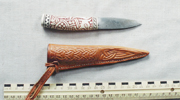
Antler handled utility knife
The handle is deer antler. I made the paints using red ochre, soot, and linseed oil (which is processed from flax seeds). Few knife handles in the archaeological record have this much decoration, but an antler carver needs to advertise his skills... The sheath is vegetable tanned leather, I worked the decoration into it while wet using the point of a bone cloak pin.
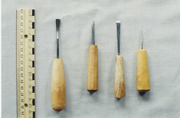
Carving tools
from left to right:
- Gouge with a wooden handle, used for hollowing spoons and carving in the round.
- Small chisel with a wooden handle, side view. The edge is about 2mm wide, and it is shaped rather like a mortising chisel because of the hardness of the bone and antler. Used for detail carving.
- Chisel with antler handle. The flared shape is typical of chisels from the Mastermyr box, and makes efficient use of the iron.
- Awl with wooden handle and square cross-section blade. Used for drilling fine holes, and scratching guide-lines.
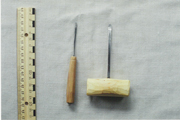
Spoon-bit augers
Two small augers for drilling holes. The smaller is sized for rivet holes for combs and belt-buckles, the larger for peg holes in wooden objects (I used it to make my tool box).
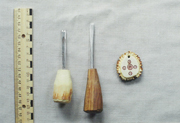
Ring and dot tools
Two tools for inscribing ring and dot decoration, a common pattern on Viking age objects such as combs and dice. The tool on the right makes medium-sized ring dots, the tool on the left scribes a larger second ring around the first. The antler pendant shows ring dots made with these tools, painted in with red ochre.
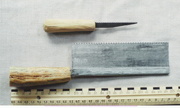
Saws
The larger saw has an antler handle and is used for cutting blanks from the raw material such as antlers and bones, and for cutting comb teeth. The smaller is for cutting decorative lines and for working raw material such and amber. Some of the straight decorative lines on Viking objects such as combs are "V" shaped in cross section, so were cut with a knife or chisel. Others have flat bottoms and parallel sides, so were cut with a saw.
 Dark Ages Re-Creation Company
Dark Ages Re-Creation Company







